What is crypto winter?

Crypto winter is a time when top cryptocurrencies quickly lose 50%+ of their value and stay that way for a year or more. Crypto traders massively sell their assets in hopes of minimizing the losses. The mainstream view on crypto becomes conservative as if the market was a bubble and it will never recover. Little do they know.
During this period, most crypto companies are at risk of going bankrupt. This depends on whether their business model relies on the company token.
For example, if your business uses tokens to finance the company, their price may fall down to a point where it wouldn’t make sense to continue operating. Likewise, the demand for your token would also drop, making it harder to reach pre-crisis KPIs.
There are 3 types of companies that can survive crypto winter:
- Large projects like Binance and Ethereum
- B2B services companies like Consensys
- Small but clever companies that readjust their product/market fit
How long can the crypto bear market last?
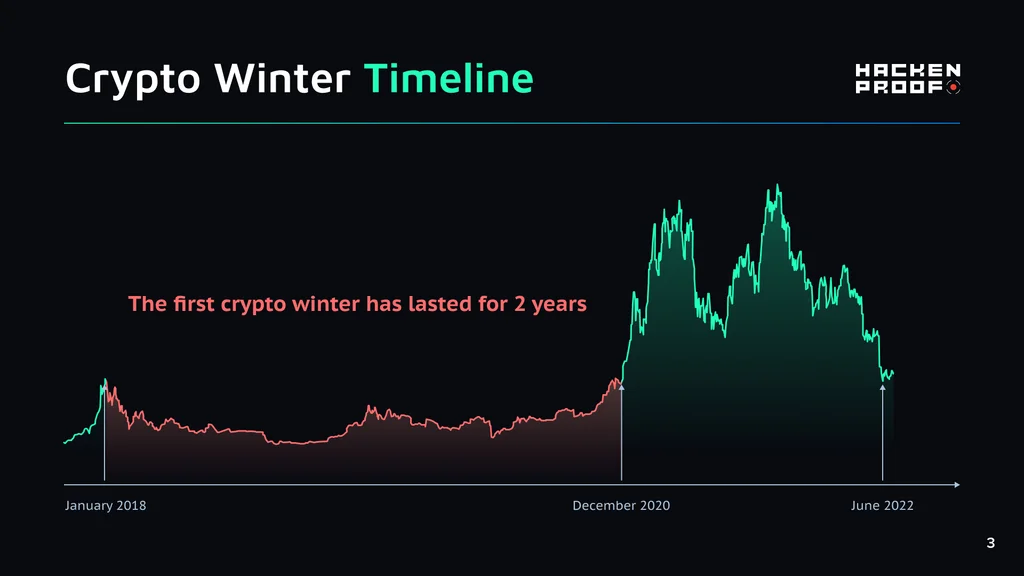
Crypto winters are long but they don’t stay forever. The first crypto winter happened in January 2018, cutting the total crypto market cap by around 65%. Back then, most of the crypto businesses were raised by Initial Coin Offerings. But one month into the crypto winter it was apparent that 46% of the ICOs went bankrupt. It took 2 years for the market to get back and enter the crypto summer of 2020… which started in the winter.
Market performance changes between bearish and bullish cycles.
A bear market is the same as the crypto winter. Small businesses struggle to survive, while large enterprises invest in security and marketing to capture the market share when it comes back online. Employee layoffs are also typical of the bearish market.
A bull market is the same as the crypto summer. Investment funds easily invest into crypto businesses, companies hire employees and grow their revenue. Bitcoin and altcoin prices are setting all-time high records, while crypto is cool again.
Understanding how long does crypto bear market last can help your company survive. This way you can plan your revenue and expenses accordingly.
How can business survive crypto winter
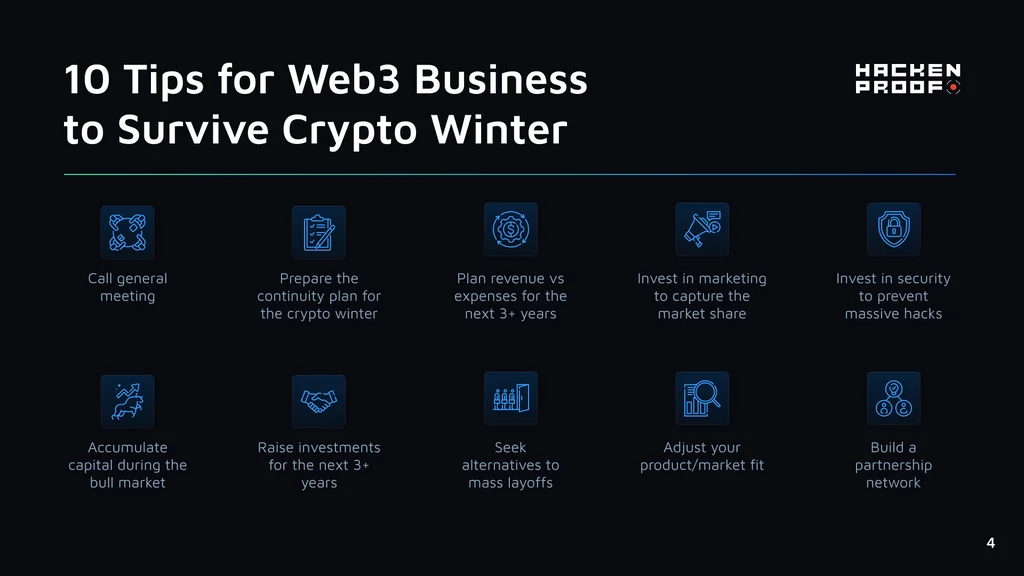
To survive crypto winter, a company should consider 10 points:
- Communicate the situation to the team in a general meeting
- Prepare the continuity plan for the crypto winter
- Plan revenue vs expenses for the next 3+ years
- Invest in marketing to capture the market share
- Invest in security to prevent massive hacks
- Accumulate capital during the bull market
- Raise investments for the next 3+ years
- Seek alternatives to mass layoffs
- Adjust your product/market fit
- Build a partnership network
Communicate the situation to the team in a general meeting

The first responsible thing to do is to gather an all-hands meeting and discuss the situation.
Your workers may be frustrated to hear about mass layoffs in the crypto space. If they don’t know about company plans, they may become unproductive in the light of likely layoff.
This meeting should reassure the team that the executive team is aware of the situation. You should explain what are the current issues and if there’s a plan to survive the crypto winter. If there’s no plan, promise your team to prepare it with a fixed deadline.
Being transparent with your employees assures your confidence in crisis management. It also motivates the team to work harder seeing how it’s a team effort.
Prepare the continuity plan for the crypto winter
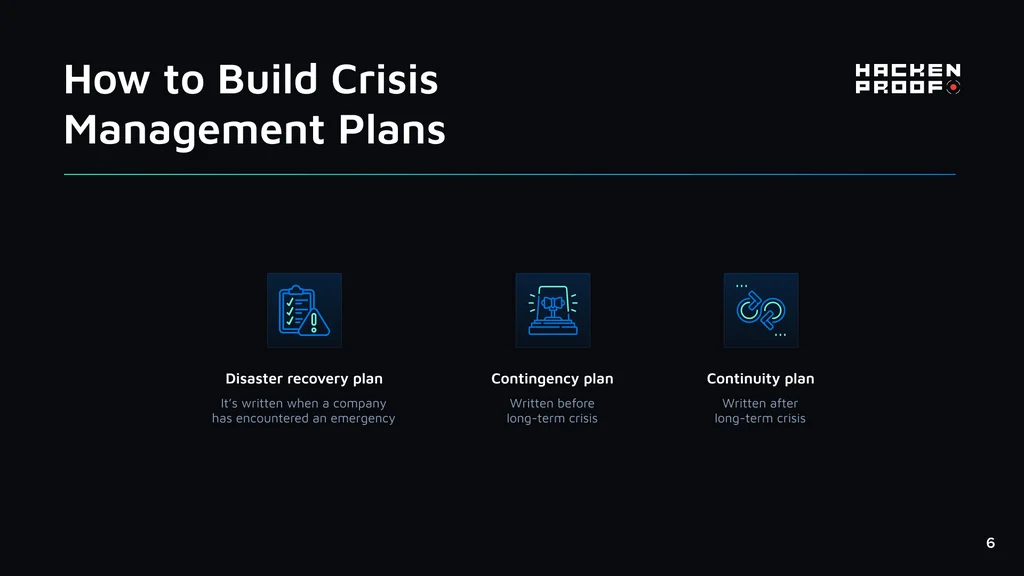
Going through the crypto winter makes you understand that you should have been prepared for this. That’s why you should focus on crisis management plans.
There are 3 crisis management plans for business:
- Disaster recovery plan
- Contingency plan
- Continuity plan
The disaster recovery plan is a step-by-step plan to recover from a business disaster. The recovery plan would account for all possible incidents like data leaks, bad press, and hacks.
For example, this plan would help you if a hacker caused damage to your business operations. The recovery plan would feature steps like contacting police and asking DevOps to investigate the incident.
Continuity and contingency plans are both solutions to have your company up & running. The difference is only in the context when you create these plans. A continuity plan is when you already have problems to solve. While a contingency plan is accounting for possible problems that may arise in the future.
If it’s crypto winter and you already have upcoming issues, you need a continuity plan. The plan should be structured like this:
- Assess bear market risks using risk matrix
- Identify top issues as of this bear market and how they affect business
- Generate worst-case scenarios and what can trigger them
- Prepare solutions to solve issues and risks
Plan revenue vs expenses for the next 3+ years
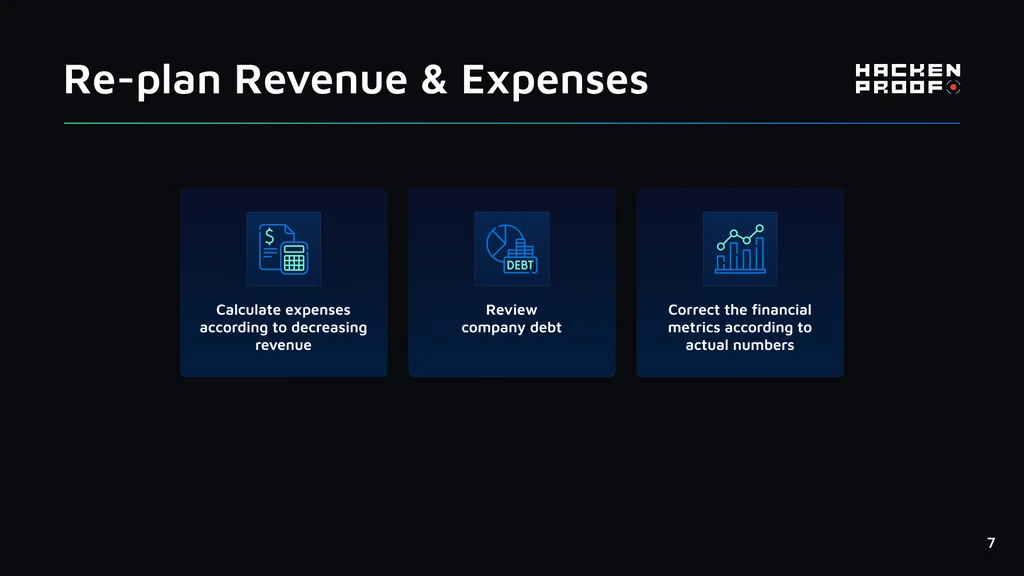
Crypto winter makes the market tighter. The demand for your business decreases, and so does your revenue. The competition increases as each company is trying to scrap what little demand is left. Regardless, you will need to adjust your growth plans for the next 3 years. The 2018 crypto winter has lasted 2 years. By accounting for the extra years, you’ll be prepared for the worst-case scenario.
In the same way as you plan to expand your revenue, you now need to plan its decrease. The trick here is to plan the decline rate in a way that would make your business stay profitable. But don’t rush with cutting all expenses. Your cost per customer should decrease naturally as your competitors cut their marketing budgets. So come back to the marketing budget one month into the crypto winter.
Don’t forget to review your company debt. Companies with a lot of debt are vulnerable during the crypto winter. Pay off the loan as soon as possible so it doesn’t add up like an avalanche.
If you’re struggling to reach the loan plan, renegotiate it with the loan company. It’ll be easy to convince them to give you a timely discount. Just let them know that they’ll receive the full amount of the loan in the long term than if you had gone bankrupt.
When your financial plan is ready, track the financial metrics by monthly and quarterly periods. By comparing the planned numbers with actual results, you’ll see how well you’re doing. You can also use real results as benchmarks to further adjust your crypto winter plan.
Invest in marketing to capture the market share

It seems counterintuitive to spend money in crypto winter. But if your long-term plan checks out, don’t cut the marketing expenses.
This logic is akin to what professional crypto traders do. When everything falls, they see it as a firesale, not a crash. As the cost of acquiring crypto comes down, it’ll be easier to make a profit.
That’s why crypto millionaires invest in bear markets and emerge in the bull cycle.
The same applies to business. As the total market pie decreases in size, the cost of acquiring the market share decreases too. This is an opportunity to capture all profitable marketing channels and come out as a leader when the bull market begins.
Invest in security to prevent massive hacks

Crypto winter makes companies fragile enough. During this time, a critical hack would be enough to KO your company – bankruptcy. The cost of cybersecurity may look expensive in the absolute value. But when you compare it to the possible losses, the relative value makes sense to allocate the budget for cybersecurity.
As part of your risk mitigation strategy, cybersecurity minimizes the chances of hacker damage.
To protect your web3 business, you’d need to run a continuous countermeasure – bug bounty.
Bug bounty invites ethical hackers to discover your company’s vulnerabilities and report on them. The idea is to outrun cybercriminals using a systemized bug discovery approach
Every time an ethical hacker reports on your bug, you’d get a notification of another risk successfully mitigated. Just don’t forget to ask the developers to fix the bug or have them receive those notifications automatically.
You can either host the bounty yourself or outsource it to a marketplace.
Accumulate capital during the bull market
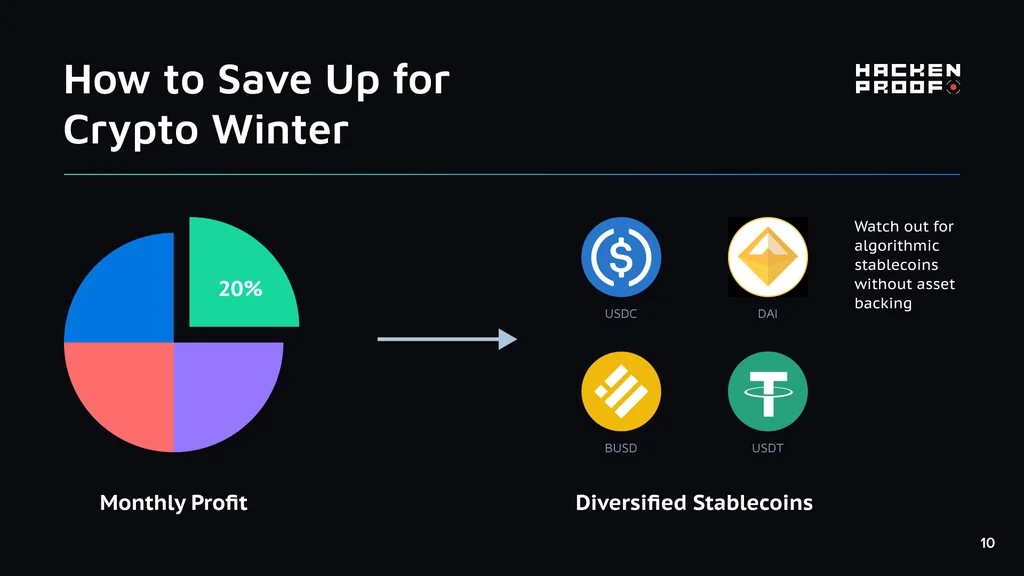
If you’re not a fan of sharing company ownership with investment funds, consider accumulating profits in a special account. It would later be used to sustain the company without firing essential team members.
To do this, you need to save at least 20% of the profit every month. Keep this money diversified across top stablecoins. But consider twice before saving in algorithmic stablecoins without asset backings.
Raise investments for the next 3+ years

If your company is struggling to meet ends, consider getting investments from the funds. Having an investment would make your team focus on building, not rushing to make revenue. However, you’d still need to prove your product/market fit by using MVP or RAT frameworks.
Apart from the viable product, you’ll need to prove that your project runs on tech, not hype. This is because the investment funds are now checking the web3 project carefully.
Apart from the viable product, you’ll need to prove that your project runs on tech, not hype. This is because the investment funds are now checking the web3 project carefully.
Seek alternatives to mass layoffs
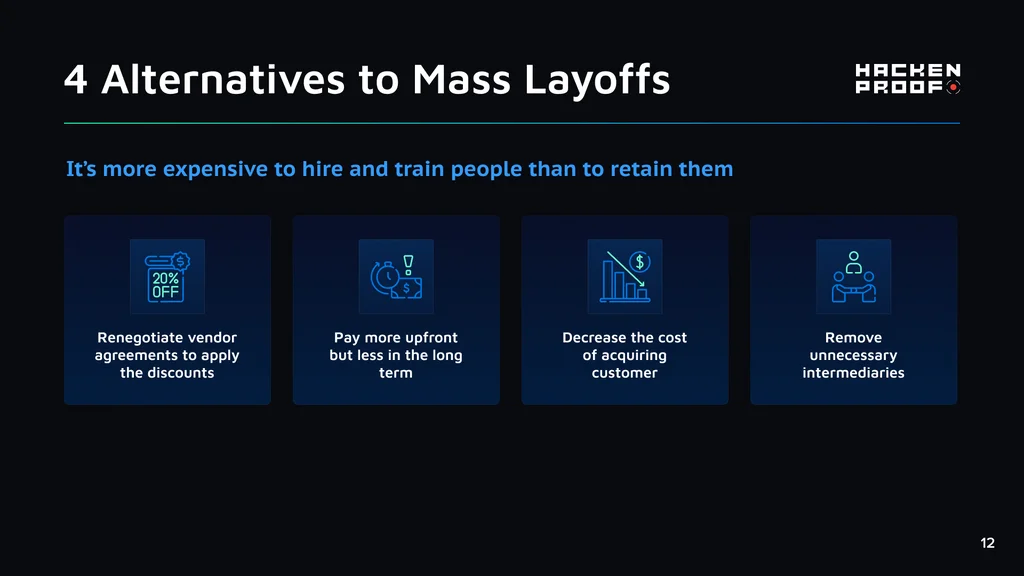
Remember to cut spending on employees responsibly. Firing many employees at once may decrease morale and trigger the productivity winter inside your company.
Instead of enacting mass layoffs, review the performance of each employee. The goal here is to find out how each team member contributes to company revenue. It would also be fair if you could provide at least 2 weeks of notice period for laid-off employees.
Laying off employees delays the true cost of this decision. It’s more expensive to hire and train people than to retain them. As an alternative, consider hour reductions, furloughs, and performance pay.
Focus on improving business operations:
- renegotiate vendor agreements to apply the discounts
- pay more upfront but less in the long term
- decrease the cost of acquiring customer
- remove unnecessary intermediaries
Adjust your product/market fit
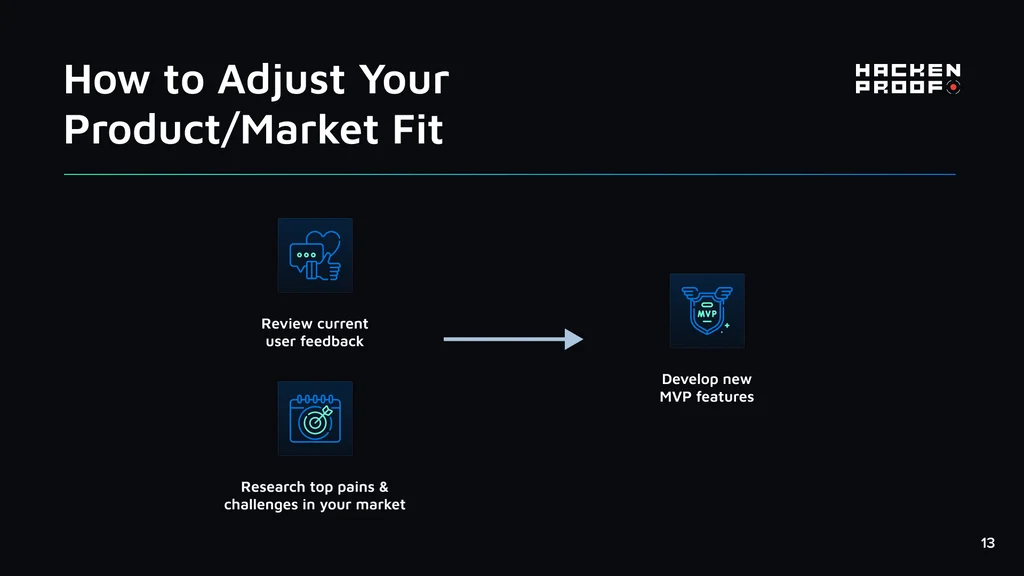
During the crypto winter, demand drops for certain services or product features. This is an opportunity to reinvent your value proposition and find a new target audience.
If you are tracking your Product/Market Fit, pay attention to the recent user feedback.
Depending on the new requests, you might be able to find a new market for the company.
Build a partnership network

As the demand for your business decreases, your marketing channels will slow down. That’s why it’s crucial to strike a deal with a market partner. They can become your referral channel.
To find the right partner, list down all sorts of websites where your potential customers hang out:
- Media
- Software
- Platform
- Marketplace
Remember that partnerships work both ways. This is why you’ll need to provide your value as a partner too. Offer them to refer your customers. You can either do it for free but expect the same from the partner. Or negotiate on the % fee. Either way, you’ll be able to create an ecosystem of businesses helping each other.
When building the network, offer your clients and partners several solutions. This way, they’ll be able to choose the best fit.
What Do Web3 Business Leaders Think of Crypto Winter
We have reached out to crypto companies to share how they plan to handle this crypto winter.

On the serious side
- Do your own research, not only on projects but also on sources of information.
- Focus on the purpose of the underlying project, not the potential return.
- The utility is key – no company, crypto or else, can be successful without an underlying purpose of its product.
- Crypto markets are correlated to traditional markets, whether you want them or not. No asset class is truly uncorrelated, especially not during economic events like a global recession.
- Accept, embrace and participate in regulatory frameworks. They add security and thus attract investors and capital.
- Have a risk management framework with defined entry and exit points. Be willing to bag losses and pocket gains, don’t let fear and greed influence your decisions.
- If a project is worth investing in, it’s probably not advertised on social media as the next unicorn.
- If you have to reduce exposure or cost, consider the long-term effect this decision will have on your business or investment.
- Leverage and debt are great tools to enhance growth and performance but carry their own sets of risks.
On the fun side (still important)
- “Apeing,” “shilling,” “wen Lambo,” and “to the Moon” is for speculators, not investors.
- Anything with an APY above traditional markets is probably not sustainable.
- “The only coin worth HODLing” has not yet been invented.
- If your grandma already holds the coin, don’t buy more into it – it’s too mainstream.
- FOMO is not an investment strategy.
Key Takeaway
Whether you have to survive a crypto winter or a global economic recession, the principles remain the same:
- Focus on value.
- Plan ahead.
- Build reserves for dire times.
- Make rational decisions.
- Adapt to the ever-changing ecosystem.
“It is not the strongest of the species that survives, nor the most intelligent, but the one most responsive to change.” — Charles Darwin , On the Origin of Species, 5th Edition, 1869.
Stay safe and warm in this crypto winter, and we will see through it just as the next one and any after that.

The inception of Pandora occurred in mid-May, amidst the crypto market crash that has left many blockchain companies and retail investors devastated. Launching during the prolonged market turmoil was a daring move. However, despite all the odds stacked against it, our one-month-old project has managed to take root and started gaining traction in the DeFi space.
There isn’t much for investors to do during crypto winter. As such, people started looking out for new ways to make profits while waiting out this rough patch. This is an opportunity for web3 companies to get more investors on board with their DeFi products. By offering innovative, low-risk means of making profits, web3 companies can prove to be the saviors of investors during this harsh time. Make more people buy into your project by keeping on diversifying and innovating new income-generating opportunities tailored towards their needs.
In Pandora’s case, the project has been able to stay afloat through market turbulence thanks in part to its unparalleled trade mining mechanism, unmatched decentralized jackpot system, and massive NFT reward pool.
Another key to persisting through crypto market chaos and thriving during the bull cycle is to strengthen your community. It’s important to keep your community members excited and engaged in what you’re doing, so they don’t feel like giving up on crypto (and your project) altogether.
Frequently communicate with your supporters about the project’s progress and updates. Pay attention to and take into consideration their feedback and expectations. Most importantly, put their ideas and suggestions into feasible action via new product releases and feature improvements. Organize community events to unite them even more.
Constantly reassure your followers that their voices matter and are heard because building a foundation of trust with your supporters is critical to the long-term success of any crypto project.

1. Renegotiate all supplier agreements. We’ve brought down supplier costs by approx 75% which has helped extend out runway.
2. Cut crappy suppliers and replace with in-house staff. It’s a little more hassle, but a higher quality output for much less.
One thing that we did from the start was to build in-house capabilities. We hired and trained permanent staff in parts of the world where resources are cheaper. Compared to western contractor rates, we make an 80-85% saving

1. Maintaining a healthy cash flow
Even the giant companies in the crypto industry will also have experienced cash flow issues when their debts are due before they’ve earned enough income from products to cover the bills.
2. Know what the user’s wants & needs
Be creative, and build products that people are happy to use, not just forking a product from other successful projects. Most project dies eventually even in a bullish market, the main reason is the lack of creativity. Promising projects and competitive services make BitForex the indispensable infrastructure for the upcoming bull market.
3. Security is also the key fundamental.
As the old word says: Code is the law in the crypto world. We have seen many exploit incidents happened on Dapps in the last bullish cycle. Web3 companies should put more effort to ensure safety and taking responsibility for their users.

To understand how Web 3.0 companies can survive this crypto winter, you need to realise that Web 3.0 is not just about NFTs and metaverses.
Modern Web 3.0 applications offer features such as DAOs, cryptocurrencies, blockchain and decentralised data storage systems, self-sovereign identity (SSI), the Internet of Things (IoT), metaverses, NFTs, and many other technologies.
Recently, the NFT and metaverse industry has begun to cool down, with volumes gradually slowing. That is why an increasing number of users began to doubt Web 3.0. However, they are wrong with such a judgment, since the architecture of the new-generation Web has great potential. The fundamental difference between Web 3.0 and Web 2.0 is increased decentralisation at all levels, including data storage and application use.
Web 3.0 involves the active use of artificial intelligence (AI). Similar principles underlie the business models of many major web platforms such as YouTube, Netflix and Amazon. Therefore, Web 3.0 will not be difficult to survive in today’s crypto winter. The potential the Web 3.0 posses just won’t let its projects die. Plus, many companies are investing in Web 3.0 development. Meta alone has invested a total of around $21 billion. Other large corporations are also actively supporting developers and enthusiasts.
Web 3.0 companies should focus on high-value talent, both in senior management and developers. Employers that offer the best experience and bring a useful product to the market are the driving force behind a company’s success.
It is also worth paying close attention to discounting cash flows. Be careful with your capital and avoid investing in less promising projects that can become toxic assets in the future. The optimal risk level is another vital point to consider. Never burden yourself with debt obligations, which can become unbearable, especially for small or medium-cap companies.

The crypto winter forces Blockchain Leaders to always have a survival mindset. We must focus on the in-house capabilities, restructure the company if needed to optimize the expenses in a few years runway. Besides, our leaders have to consider about the market fit and go-to-market strategies as the market conditions have now changed compared to the bull cycle.
Instead of mass marketing, we might focus on building from the basic, such as products, real traction rather than hype with a long-term vision. We, SotaTek and any other Web3 companies all aim to survive the current economic downturn, and are ready to flourish in the following years to come.

The economic impact of all the events occurring this year 2022 will have consequences in the next months and years. Projects with a strong team and community will not only survive this crypto-winter but will become the reference for future web3 companies.
At Nimbus Platform we are working with the major audit companies in the world, fine-tuning every internal process that makes us release ever more high-quality products, and bringing more and more talent to our squads.

By the time we entered the bearish market, we were already developing a new bridge architecture.
We are currently building a stablecoin bridge that enables native transfers between EVM and non-EVM chains. The new product is the evolution of our existing bridge and its primary goal is to enhance the user journey by offering a seamless cross-chain experience.
One cannot deny that volumes will be comparatively lower than they could be in bullish times. Despite it, stablecoin bridge functionality is a much-needed tool in the cross-chain space.
Our business model focuses on the fees received from transfers, which is why it allows us to maintain our presence in any cycle.
While the native stablecoin bridge is primarily a B2C product, we are diversifying our risks and developing our B2B direction.
We are working on a Bridge-as-a-Service solution, targeting companies needing personalized bridge services integrated within their interface.
Last but not least, our existing bridge will remain a platform with unique bridging options such as XRP Ledger and NEAR Protocol.
More integrations will be coming to our bridge within the next few months, and we will continue maintaining our position as a non-EVM-oriented bridge provider.

1) Retaining, training, and growing industry talent for all areas of business
2) Upgrading features and adding new products
3) Taking the time for offsite events for teams and users
BTSE is keeping the energy strong and forming even stronger connections between our team, partners, and users. We are prepared to serve our users under any market conditions. Our team is motivated to remain resilient and continuously ship products through the crypto winter until we see spring.

1. Focus on staking. It can become a nice revenue source for those who don’t plan to do anything with their assets until the market grows again.
2. Diversify your portfolio. It can increase the efficiency and investment appeal of the portfolio when the assets will grow.
3. Fact check your sources. There is much disinformation on the market. It can become the source of FUD (Fear, Uncertainty, Doubt). This is basically a tactic for psychological manipulation.
The goal of FUD is to communicate an information in away that would seed doubt in something like crypto investing. It’s mostly used by propaganda professionals to shift the context for their gain.
To avoid FUD, you need to read information from verified and objective sources. For example, like this one 🙂

To do this, they need to find out the single aspect with the most powerful impact out of the broad prospects of their teams. Then, try to make breakthroughs in the single aspect by gathering the power of the whole team to leave a strong impression for users and VC, just as the design of iPhone was simplified into just a single home button, which made the user experience of the product gain overwhelming success in the market.

Coinstore believes that the current downturn could last for months or even years. Since the encryption winter is inevitable, it is important to motivate the team, and keep the spirits up.
Although we will take more careful steps but that will not hinder our growth. We will continue to be innovative in our products, and be ready for the next market upturn. Coinstore Global has recently invested in several WEB3.0 encryption start-up projects.
We are constantly looking out for projects that can provide stable and sustainable multi-token application scenarios and have broader ecological prospects. Such features will undoubtedly provide more help for future projects to add value.

FAQ
How can business prepare for the crypto bear market?
To prepare for the crypto winter, a web3 company should consider 4 points:
- Accumulate capital during the bull market
- Prepare the contingency plan for the crypto winter
- Raise investments for the next 3+ years
- Build a partnership network
How much money should web3 company save for the crypto bear market?
Save at least 20% of your profit every month. Keep the savings in different stablecoins backed by assets. Ideally, you’d need to calculate how much profit are you willing to save. Especially when it comes to opportunity costs like marketing and technology.

